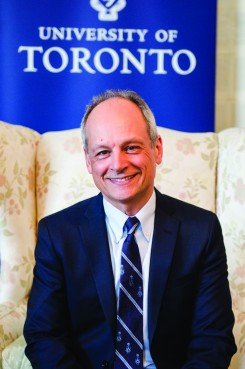Last December, the University of Toronto welcomed its sixteenth president, Meric Gertler, with a distinctive mix of apprehension and congratulatory exuberance. While Gertler is no stranger to the university’s intimate workings — as the former Dean of the Arts and Science faculty — the weight of the challenges our university faces leaves room for a substantial array of concerns. Few individuals, however qualified, can be expected to single-handedly tame sustained structural unemployment, declining government funding for liberal arts programs, and a set of increasingly competitive online educational opportunities. Transforming the educational experience on campus will require Gertler to reassess the university’s local and global partnerships.

FILE PHOTO: BERNARDA GOSPIC/THE VARSITY
It will require a neighbourhood approach to addressing the workplace’s needs as they balance with the broader community’s need for educated and publicly engaged citizens. Failure to engage with either set of interests, or to emphasize the need to produce world-leading graduates regardless of financial obstacles to higher education, is sure to endanger U of T’s prized position on global higher education rankings.
Outgoing president David Naylor’s term at the university’s helm heralded a decisive transition away from the stodgy, traditionalist ways. Political factors were pulled from under the university’s feet as firmer educational funding terms were required to prevent a higher-education debt bubble. The rise of emerging markets prompted the university’s most respected rivals and admirers alike to invest substantial funds in satellite campuses and world-class educational facilities to match an ever-rising global competition for the very best students.
On the ground, Naylor’s term was punctuated by one construction site after another, as U of T responded to these global trends with a concerted push to improve infrastructure, facilities, and program offerings. Bystanders saw efforts to make our professional faculties more competitive globally, as the business school faculty was integrated into many engineering programs, with an emphasis on commercialization of radical homegrown innovations. Gertler’s challenge, at the time of writing, will be to drive this adaptive momentum into a viable, responsive, and necessarily fundamental reorganization of undergraduate education, in order to best take advantage of the new vistas made available by his predecessors.
Gertler’s strategy to address its main challenges is to reconfigure the university’s relationship with the City of Toronto, particularly its funders and government backers, with a greater proposed role for U of T in municipal and provincial-level discussions on innovation and policy. By rethinking these relations, Gertler hopes to recalibrate university curricula and offerings, in order to strike the right balance between the traditional ambitions of well-rounded, higher education with the pointed, practical exigencies of the contemporary workplace.
These goals and stated ambitions are laudable, but they are anchored on the conditional hope that provincial governments will volunteer to jump to the liberal arts and non-professional programs’ defense. If this is not the case, as current discussions of intended strategy suggest, then we might be witnessing the receding line of accessible liberal arts education in Ontario. Indeed, if we need to halt structural unemployment, and if the private sector and its government-backing corollaries are in favour of equipping the Ontario student with the right skills, then departments with the least apparently monetizable course content will see themselves bunched together and plausibly starved to the professional faculties’ benefit.
However, before we run to the slippery slopes, it is essential to underline that Gertler seems to favour a balance of both worlds: a liberal arts curriculum with a backbone of employable skills. An observer of this dilemma — an old one at that, but one that is more urgent given the times — might suggest that we also look to non-governmental sources of educational funding for the least unemployable faculties. Making these programs viable, regardless of how many billions our Ivy League competitors are spending or how many MBAs are required in the workplace, could be an opportunity for greater private-public partnerships for non-professional faculty educational funding.
Regardless of the financial constraints on traditional liberal arts’ survival in a province such as Ontario, which is rife with structural unemployment, Gertler’s perspective is one that promises to engage with all stakeholders. Joint program offerings, joint research symposiums, and greater faculty engagement in the local community’s various needs promise to make the university that much more relevant. If there is a way to gain this greater relevance and employability while educating well-rounded graduates, it will definitely be found in greater consultation with our neighbours, locally and globally. In the age of super competition in higher education, it will definitely take a global village to raise employable, liberal arts educated graduates.
Yves Guillaume A. Messy is in his final year of a specialist in political science. He is a political commentator on CTV National News.


